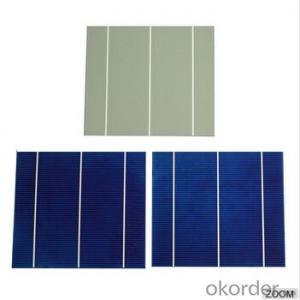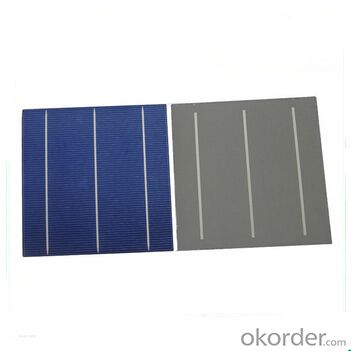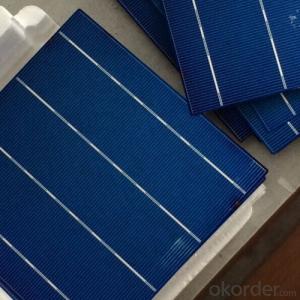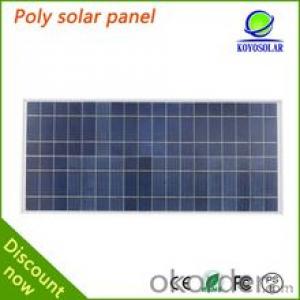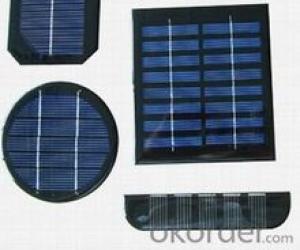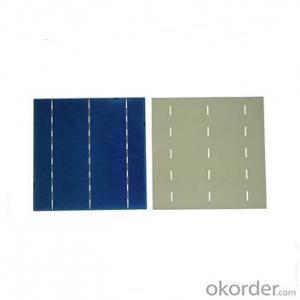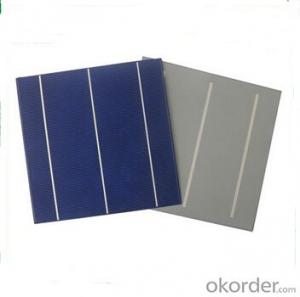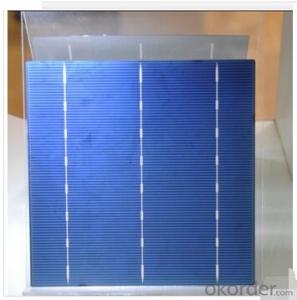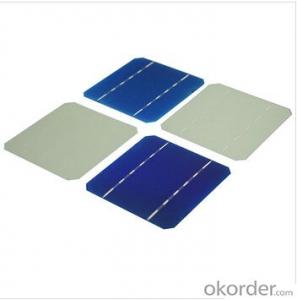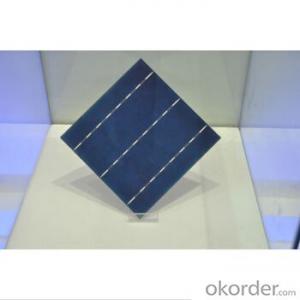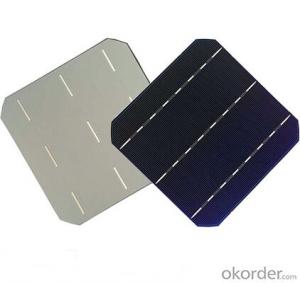Tasc Solar Cells - Polycrystalline Solar Cell High Quality 16.80%-17.99% Effy
- Loading Port:
- Shanghai
- Payment Terms:
- TT OR LC
- Min Order Qty:
- 1000 pc
- Supply Capability:
- 1000000 pc/month
OKorder Service Pledge
OKorder Financial Service
You Might Also Like
Solar Cells:
solar cells, when struck by photons of light from the sun, generates an electrical current which can then be used to power DC or AC electrical loads.
A solar cell is made of silicon. Computer chips are made of this same material. Basically, when light strikes the surface of a solar cell some of it is absorbed into the silicon. This light energy bumps the electrons loose and causes energy to flow
Solar cells is made by solar wafer, it has three categories of solar cell right now, monocrystalline polycrystalline and thin film,These cells are entirely based around the concept of PN junction, which is the critical part of solar module, it is the part that can convert the light energy into electricity, the thickness is from 180um to 200um, with even busbars to conduct electricity, textured cell can decrease diffuse reflection; they are often electrically connected and encapsulated as a module. Photovoltaic modules often have a sheet of glass on the front (sun up) side, allowing light to pass while protecting semiconductor wafers from abrasion and impact due to wind-driven debris, rain, hail, etc. Solar cells are also usually connected in series in modules, creating an additive voltage. Connecting cells in parallel will yield a higher current;With high quality and stable quality. Our Cells can greatly improve the performance of Solar Modules.
Specifications
| Efficiency | Power | Max Power Current | Min Power Current | Max Power Voltage | Short Circuit Current | Open Circuit Voltage |
| Eff(%) | Ppm(W) | Ipm(A) | Ipm(A) | Vpm(V) | Isc(A) | Voc(V) |
| 17.80-17.99 | 3.89 | 7.50 | 7.38 | 0.527 | 8.04 | 0.630 |
| 17.60-17.79 | 3.84 | 7.45 | 7.32 | 0.525 | 7.94 | 0.628 |
| 17.40-17.59 | 3.80 | 7.40 | 7.25 | 0.523 | 7.90 | 0.629 |
| 17.20-17.39 | 3.76 | 7.35 | 7.17 | 0.518 | 7.86 | 0.628 |
| 17.00-17.19 | 3.71 | 7.3 | 7.10 | 0.516 | 7.80 | 0.625 |
| 16.80-16.99 | 3.67 | 7.25 | 7.05 | 0.514 | 7.75 | 0.623 |
Solar Cells Advantage:
• High efficiency and stable performance in photovoltaic conversion.
• Advanced diffusion technique ensuring the homogeneity of energy conversion efficiency of the cell.
• Advanced PECVD film forming, providing a dark blue silicon nitride anti-reflection film of homogenous color and attractive appearance.
• High quality metal paste for back surface and electrode, ensuring good conductivity, high pulling strength and ease of soldering.
• High precision patterning using screen printing, ensuring accurate busbar location for ease with automatic soldering a laser cutting.
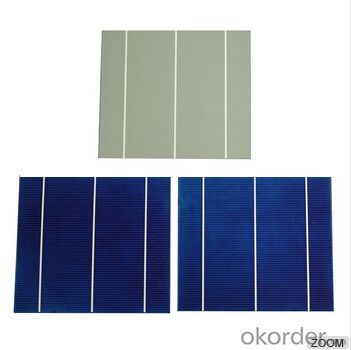
FAQ
We have organized several common questions for our clients,may help you sincerely:
①What price for each watt?
It depends on the efficiency of the solar cell, quantity, delivery date and payment terms.
②How long can we receive the product after purchase?
In the purchase of product within three working days, We will arrange the factory delivery as soon as possible. The pecific time of receiving is related to the state and position of customers.Commonly 7 to 10 working days can be served.
③Can you provide the peripheral products of the solar panels, such as the battery, controller, and inverter? If so, can you tell me how do they match each other?
Yes, we can, we have two companies for solar region, one is CNBM International, the other is CNBM engineering Co.
We can provide you not only the solar module but also the off grid solar system, we can also provide you service with on grid plant.
④What is your warranty of solar cell?
Our product can promise lower than 0.3% open box crack, we support claim after opening the box if it has crackm color difference or sth, the buyer should give pictures immediately, we can not accept the claim after the solar cell has assembled to solar panel.
• Timeliness of delivery
• ⑤How do you pack your products?
We have rich experience on how to pack the solar cell to make sure the safety on shipment, we could use wooden box or pallet as buyer's preference.
- Q: What is the future of solar cell technology?
- The future of solar cell technology holds great potential for advancements in efficiency, affordability, and integration into various applications. Researchers are constantly exploring new materials, such as perovskites and organic polymers, to overcome the limitations of traditional silicon-based solar cells. Innovations like tandem solar cells and multi-junction solar cells are expected to significantly increase conversion efficiency. Additionally, advancements in manufacturing techniques, such as printing and roll-to-roll processes, aim to reduce production costs and facilitate large-scale deployment. Integration of solar cells into everyday objects, like windows, clothing, and electronic devices, is also an exciting prospect. Overall, the future of solar cell technology seems promising and will play a crucial role in transitioning towards a more sustainable and renewable energy future.
- Q: How do solar cells handle electromagnetic fields from power lines?
- Solar cells are designed to convert sunlight into electricity, and they do not have the ability to handle or interact with electromagnetic fields from power lines.
- Q: What are the advantages of monocrystalline silicon and polycrystalline silicon in solar power?
- and the production process of polysilicon can be achieved by casting method and direct solidification method. Grain size of the grain size of centimeters; [4] due to nearly a decade of monocrystalline silicon technology research and development soon, in which the process is also used in the production of polycrystalline silicon cells, such as the choice of corrosion emission junction, back surface field, , Surface and body passivation, fine metal gate electrode, the use of screen printing technology can reduce the width of the gate electrode to 50 microns, the height of 15 microns or more, rapid thermal annealing technology for polysilicon production can greatly shorten the process time,
- Q: Can solar cells be installed on sloped surfaces?
- Yes, solar cells can be installed on sloped surfaces. In fact, solar panels are commonly installed on sloped rooftops to harness sunlight efficiently. However, the angle of the slope may affect the overall energy output, so it is important to consider the optimal tilt and orientation of the solar panels for maximum efficiency.
- Q: How do solar cells perform in areas with high levels of industrial emissions?
- Solar cells can still perform effectively in areas with high levels of industrial emissions. While industrial emissions can potentially reduce the overall performance of solar cells due to air pollution and particulate matter, the impact can vary depending on the specific pollutants and their concentration. Regular cleaning and maintenance of the solar panels can help mitigate any negative effects. Additionally, advancements in solar cell technology, such as anti-reflective coatings and improved efficiency, can enhance their performance even in challenging environments.
- Q: How do solar cells handle electromagnetic radiation?
- Solar cells handle electromagnetic radiation by converting it into electrical energy. When sunlight (which is a form of electromagnetic radiation) strikes the solar cell, it excites electrons, allowing them to flow through the material, creating an electric current. The materials used in solar cells are designed to efficiently absorb and convert a wide range of electromagnetic radiation, including visible light and some parts of the infrared and ultraviolet spectrum.
- Q: Can solar cells be used in powering irrigation systems?
- Yes, solar cells can be used to power irrigation systems. Solar panels can convert sunlight into electricity, which can then be used to power pumps and other components of an irrigation system. This is a sustainable and cost-effective solution, especially in areas with abundant sunlight, as it reduces the dependency on traditional energy sources and can provide a reliable source of power for irrigation.
- Q: Can solar cells be used in cloudy weather?
- Yes, solar cells can still generate electricity in cloudy weather. While the efficiency of solar cells decreases in low light conditions, they can still capture and convert sunlight into usable energy. However, the amount of electricity produced may be lower compared to sunny conditions.
- Q: Can solar cells be used in healthcare facilities?
- Yes, solar cells can be used in healthcare facilities. They can help power various equipment and devices, such as lighting, ventilation systems, and medical equipment, reducing reliance on traditional energy sources and lowering operational costs. Additionally, solar power can be utilized in remote and off-grid healthcare facilities, ensuring access to clean and sustainable energy for essential healthcare services.
- Q: How is the solar cells factories working in China? Do they follow certain quality standards?
- The solar cells factories in China is actually working very well. Because of the low cost and good quality, they are exporting a lot of solar cell product to overseas.
Send your message to us
Tasc Solar Cells - Polycrystalline Solar Cell High Quality 16.80%-17.99% Effy
- Loading Port:
- Shanghai
- Payment Terms:
- TT OR LC
- Min Order Qty:
- 1000 pc
- Supply Capability:
- 1000000 pc/month
OKorder Service Pledge
OKorder Financial Service
Similar products
Hot products
Hot Searches
Related keywords
